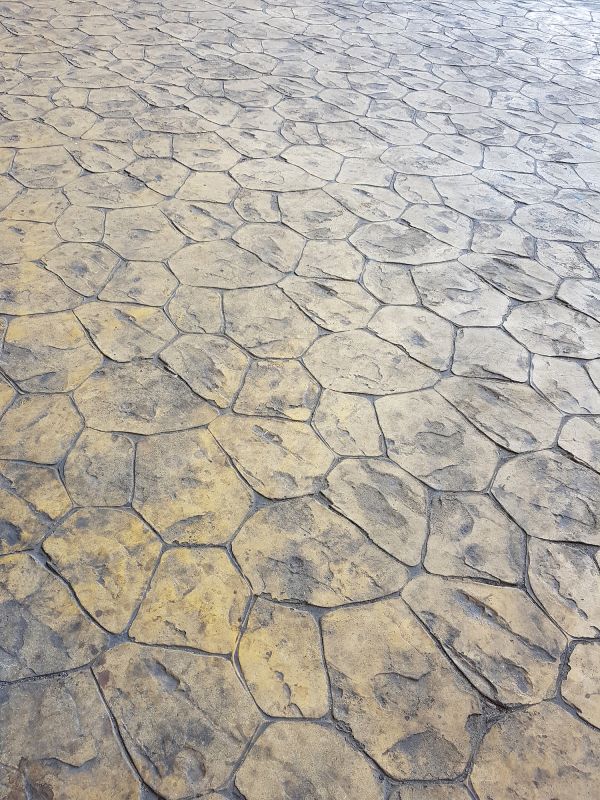Popular Options For Stamped Concrete Protection To Enhance Longevity
Find out which protective products are favored for keeping stamped concrete surfaces resilient against wear and damage.
 Stamped concrete is a popular choice for adding decorative appeal to patios, walkways, and driveways. To maintain its appearance and durability, proper protection is essential. There are various products designed to shield stamped concrete from common issues such as staining, surface wear, and weather-related damage. These protective solutions help extend the lifespan of the decorative surface while preserving its aesthetic appeal.
Stamped concrete is a popular choice for adding decorative appeal to patios, walkways, and driveways. To maintain its appearance and durability, proper protection is essential. There are various products designed to shield stamped concrete from common issues such as staining, surface wear, and weather-related damage. These protective solutions help extend the lifespan of the decorative surface while preserving its aesthetic appeal.
Top Overall Option
High-Performance Concrete Sealant
A versatile, clear sealant designed to provide durable protection against stains, moisture, and UV damage. It is easy to apply and suitable for various stamped concrete surfaces, helping to preserve their appearance over time.
Types of Products For Stamped Concrete Protections
Acrylic Sealers
Water-based or solvent-based acrylic sealers offer a protective layer that enhances color and provides resistance against stains and water penetration.
Polyurethane Sealers
Polyurethane sealers deliver a tough, chemical-resistant coating ideal for high-traffic areas requiring extra durability.
Epoxy Coatings
Epoxy coatings provide a thick, durable surface layer that can fill minor imperfections and add a glossy finish.
Penetrating Sealers
These sealers seep into the concrete to protect against moisture and staining without changing the surface appearance.
Silane and Siloxane Sealers
Specialized sealers that offer deep penetration and excellent water repellency for long-term protection.
Clear Protective Coatings
Transparent coatings designed to shield stamped concrete surfaces while maintaining their natural look.
Anti-Slip Sealers
Sealants with added texture or additives to improve slip resistance on stamped concrete surfaces.
UV Resistant Coatings
Products formulated to prevent fading and surface deterioration caused by sun exposure.
Overlay Materials
Protective overlays that can be applied over existing stamped concrete for added durability and aesthetic refresh.
Water Repellents
Products that create a water-resistant barrier, helping to prevent water infiltration and freeze-thaw damage.
Bonding Agents
Adhesives that improve the adhesion of sealers or overlays to stamped concrete surfaces.
Surface Restorers
Products designed to restore and protect the surface, filling in minor imperfections and enhancing appearance.
Popular Choices
Widely used for their ease of application and effective protection against stains and moisture.
Chosen for their durability in high-traffic areas, providing long-lasting surface protection.
Popular for maintaining the natural look of stamped concrete while providing water resistance.
Favored for their glossy finish and strong protection, especially in commercial or garage settings.
Trusted for their deep penetration and long-lasting water repellency properties.
Effective in outdoor settings to prevent fading and surface degradation due to sun exposure.
Ideal for areas prone to moisture or where slip resistance is a priority.
Popular for preserving the natural look of stamped concrete while adding protection.
Frequently chosen to prevent water infiltration and reduce freeze-thaw damage.
Used to refresh and protect existing stamped concrete surfaces, filling minor imperfections.
Applying a suitable sealant or protective coating can significantly enhance the resilience of stamped concrete. These products form a barrier against moisture, dirt, and UV rays, which can cause fading or surface deterioration over time. Regular maintenance with the right protective products can keep stamped concrete looking vibrant and well-maintained for years.
Choosing the appropriate protection depends on factors like the location of the concrete, expected foot or vehicle traffic, and exposure to the elements. Some products are designed for easy application and quick drying, making routine maintenance straightforward. Others offer specialized features such as slip resistance or enhanced UV protection to suit specific needs. Proper selection and application of these products can help prevent common issues and reduce the need for costly repairs.
In addition to sealants, there are also protective overlays and coatings that can be applied for more comprehensive coverage. These products can fill in minor surface imperfections and provide a fresh, uniform appearance. When selecting protection for stamped concrete, it is important to consider compatibility with existing surfaces and the ease of future reapplications. Overall, investing in quality protective products is a proactive approach to maintaining the beauty and integrity of stamped concrete surfaces.
Key Buying Considerations
- Determine the primary purpose of protection, such as stain resistance, surface durability, or UV protection.
- Choose a product compatible with stamped concrete surfaces and existing coatings.
- Consider the ease of application, including whether it requires professional installation or can be DIY applied.
- Evaluate the drying and curing time to fit your maintenance schedule.
- Look for products with appropriate slip resistance features if safety is a concern.
- Assess the level of water and moisture resistance needed based on climate and location.
- Check if the product offers UV protection to prevent fading or discoloration over time.
- Review the longevity and reapplication intervals to ensure long-term protection.
- Consider the appearance after application; some coatings may alter the surface look or gloss.
- Ensure proper surface preparation before applying any protective product for optimal results.
- Verify if the product is suitable for high-traffic or vehicular areas if applicable.
- Look for products that are easy to clean and maintain after application.
- Be aware of any specific application instructions or environmental conditions required during application.
- Compare costs relative to coverage area and durability features.
- Read customer reviews and expert recommendations to gauge real-world performance.
